
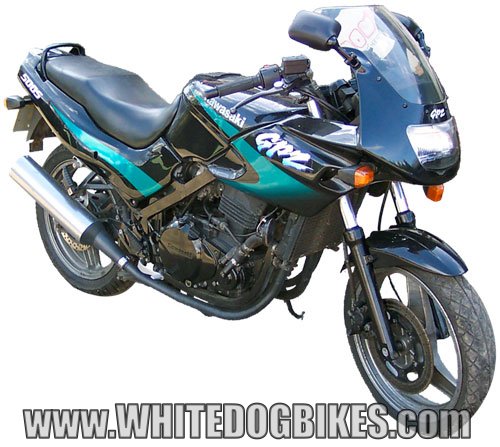
1998 Kawasaki GPZ500 S (‘R’ reg – D5 model)
Kawasaki GPZ500S Specs…..
The Kawasaki GPZ500S was a bikini faired, 498cc sports motorcycle produced by Kawasaki in the UK between 1987 and 2004.
Confusingly, the bike was called the ‘GPZ500S’ in Europe and the UK, the ‘EX500’ in the US and other areas for a while then the name outside Europe was changed to the ‘Ninja 500’ in the mid 1990’s and the Ninja 500R in the late 1990’s).
The GPZ 500 S was a popular mid range sports bike with good reliability, decent handling and a good engine that loved to be revved. The bike was marketed to the ‘biking on a budget’ crowd, and although this showed in some areas (like brakes and shocks), it was generally cheap to run, maintain and insure making it very popular with commuters, 1st time ‘big’ bikers and couriers.
Although probably a bit ‘long in the tooth’ by today’s standards, it’s still a popular bike and things like the fairing and engine still make it fun to ride for commuting or a weekend blast.
Need parts for your GPZ500S? Kawasaki GPZ500 parts on Amazon…
A little bit about the Kawasaki GPZ 500…..
Basic model info… |
|
|---|---|
| Manufacturer: | Kawasaki |
| Model: | GPZ500S |
| Model code: | EX500 |
| Also known as: | EX500, Ninja 500 and Ninja 500R |
| CC: | 498cc |
| Engine type: | Parallel-twin (4 stroke) |
| Years in production: | 1987 to 2004 |
| Style of bike: | Sports bike |
| Insurance: | Group 8 (of 17) |
Servicing your bike? You’ll need a GPZ500S workshop manual…
Models and years (in the UK) |
|
|---|---|
|
|
| EX500 A1 (Jan 1987 to April 1988)….. | |
| Frame number started: | EX500A-000001- |
| Description: | Middle weight sports bike with an 8 valve, water cooled parallel twin cylinder engine producing around 59 bhp. The GPZ500S also featured box section frame, lightweight 16 inch cast wheels, side and center stand, single disc front brake, drum rear brake, 2 into 2 exhaust with alloy wrapped end cans and a half fairing and belly pan. |
| Available colours: | Ebony or red |
| Price (new): | |
| EX500 A2 (May 1988 to Dec 1989)….. | |
| Frame number started: | EX500A-010001- |
| Description: | Same as above model with new graphics (‘twin cam 8 valve’ logo on the sides of the fairing) and a new ‘limited edition’ colour added to the range. |
| Available colours: | Ebony, red or ‘limited edition’ green/white |
| Price (new): | |
| EX500 A3 (Jan 1989 to Aug 1990)….. | |
| Frame number started: | EX500A-020501- |
| Description: | Same as above model but with ‘500S’ logo on the belly pan. |
| Available colours: | Red/white or white/grey |
| Price (new): | |
| EX500 A4 (Sept 1990 to Dec 1990)….. | |
| Frame number started: | EX500A-033001- |
| Description: | Same as above model. |
| Available colours: | Blue/white or red/white |
| Price (new): | £2949 |
| EX500 A5 (Jan 1991 to Dec 1991)….. | |
| Frame number started: | EX500A-060001- |
| Description: | Same as above model. |
| Available colours: | Ebony/grey or red/white |
| Price (new): | £3370 |
| EX500 A6 (Jan 1992 to Jan 1994)….. | |
| Frame number started: | |
| Description: | Same as above model with new graphics and no longer has the ‘twin cam 8 valve’ logo on the side of the fairings. |
| Available colours: | Ebony/grey or blue/white |
| Price (new): | £3499 for a ‘J’ reg £3425 for a 1992 ‘K’ reg £3365 for a 1993 ‘K’ reg £3495 for a 1993 ‘L’ reg |
| EX500 D1 (Feb 1994 to Dec 1994)….. | |
| Frame number started: | EX500D-000001- |
| Description: | Now has rear disc brake, new, larger 37mm forks, 17 inch front and rear wheels, new bodywork and lower seat height. |
| Available colours: | Black or wine red |
| Price (new): | £3995 |
| EX500 D2 (Jan 1995 to Dec 1995)….. | |
| Frame number started: | EX500D-009001- |
| Description: | Same as above model with new graphics. |
| Available colours: | Red or blue |
| Price (new): | £4095 for an ‘M’ reg £4195 for an ‘N’ reg |
| EX500 D3 (Jan 1996 to Dec 1996)….. | |
| Frame number started: | |
| Description: | Same as above model. |
| Available colours: | Red/grey or ebony/grey |
| Price (new): | £4395 |
| EX500 D4 (Jan 1997 to Dec 1997)….. | |
| Frame number started: | |
| Description: | Same as above model. |
| Available colours: | Black or red |
| Price (new): | £4395 |
| EX500 D5 (Jan 1998 to Oct 1998)….. | |
| Frame number started: | EX500D-040001- |
| Description: | Same as above model. |
| Available colours: | Same as above model. |
| Price (new): | £4395 |
| EX500 D6 (Nov 1998 to Dec 1999)….. | |
| Frame number started: | JKAEX500DDA048001- |
| Description: | Same as above model. |
| Available colours: | Black pearl or candy red |
| Price (new): | £3450 for an ‘S’ reg £3450 for a ‘T’ reg £3550 for a ‘V’ reg |
| EX500 D7 (Jan 2000 to Oct 2001)….. | |
| Frame number started: | JKAEX500DDA055001- |
| Description: | Same as above model. |
| Available colours: | Blue or ebony |
| Price (new): | £3750 for a ‘V’ reg £3750 for a ‘W’ reg £3750 for a 2000 ‘X’ reg £3795 for a 2001 ‘X’ reg £3795 for a ‘Y’ reg £3795 for a ’51’ reg |
| EX500 E9 (Nov 2001 to Oct 2002)….. | |
| Frame number started: | |
| Description: | Same as above model. |
| Available colours: | |
| Price (new): | £3750 |
| EX500 E10 (Nov 2002 to Oct 2003)….. | |
| Frame number started: | |
| Description: | Same as above model. |
| Available colours: | |
| Price (new): | £3795 |
| EX500 E11 (Nov 2003 to Oct 2004)….. | |
| Frame number started: | |
| Description: | Same as above model. |
| Available colours: | |
| Price (new): | £4145 |
| EX500 E12 (Nov 2004 – Discontinued)….. | |
| Frame number started: | |
| Description: | Same as above model. |
| Available colours: | |
| Price (new): | £4145 |
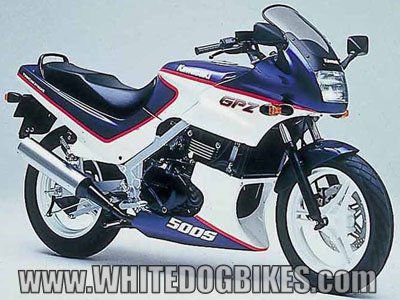
GPZ500S in blue and white
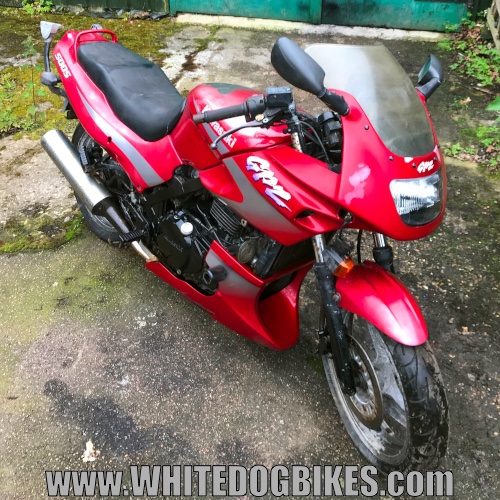
1999 GPZ500S D6 model in candy red
Engine and gearbox specs….. |
|
|---|---|
| Displacement: | 498 cc |
| Engine type: | Parallel-twin |
|
|
| Stroke: | 4 stroke |
| Bore×Stroke: | 74x58mm |
| No. of cylinders: | 2 |
| Cam shaft configuration: | DOHC (double overhead cam) |
| Compression ratio: | 10.8:1 |
| Cylinder compression pressure (GPZ500 A – Up to Jan 1994): | 8.8 to 13.5 bar (128 to 196 psi) |
| Cylinder compression pressure (GPZ500 D/E – Feb 1994 onwards): | 9.0 to 13.8 bar (131 to 200 psi) |
| Valves: | 8 valve (4 per cylinder) |
| Spark plug (GPZ500 A – Up to Jan 1994): | NGK DR8ES (x2) |
| Spark plug (GPZ500 D/E – Feb 1994 onwards): | NGK DR9EA (x2) |
| Spark plug gap: | 0.6 to 0.7mm |
| Spark plug torque: | 14nm |
| Firing order: | 1 – 2 |
| Engine oil (GPZ500 A – Up to Jan 1994): | 10w40 API SE/SF or higher |
| Engine oil (GPZ500 D/E – Feb 1994 onwards): | 10w40 API SG or higher
|
| Engine oil capacity (GPZ500 A – Up to Jan 1994): | 3.0 litres |
| Engine oil capacity (GPZ500 D/E – Feb 1994 onwards): | 3.4 litres |
| Engine oil drain bolt location: | Bottom/underneath of the engine |
| Oil filter type: | Canister type |
| Oil filter (GPZ500 A1 to A4 – Up to Dec 1990): | Hiflo HF202 / Filtrex OIF003 |
| Oil filter (GPZ500 A5, Jan 1991 onwards): | Hiflo HF303 / Filtrex OIF006 |
| Oil filter torque: | 10nm |
| Cooling system: | Liquid cooled |
| Cooling system capacity: | 1.8 litres |
| Clutch: | Wet (oil immersed) multiplate clutch |
| Clutch operation: | Cable |
| Clutch lever free play: | 10 to 20mm |
| Gearbox: | 6 Speed manual (1st gear down, 2nd to 6th gears up, neutral between 1st and 2nd gears) |
| BHP: | 49 bhp |
| Torque: | 34 ft/lb |
| Top speed (claimed): | 125 mph |
| 0 to 60mph time (claimed): | 3.76 seconds |
| Quater mile time (claimed): | 12.7 seconds |
|
|
| Piston ring to cylinder bore clearance: | New: 0.043mm / Max 0.070mm |
| Valve clearance (inlet): | 0.13mm to 0.18mm (when cold) |
| Valve clearance (exhaust): | 0.18mm to 0.23mm (when cold) |
| Idle speed (GPZ500 A – Up to Jan 1994): | 1,150 to 1250rpm |
| Idle speed (GPZ500 D/E – Feb 1994 onwards): | 1,200rpm (+/- 50) |
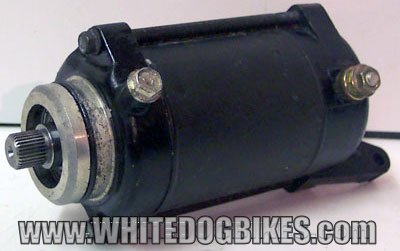
Starter motor from a 1998 ‘D5’ model
Final drive stuff….. |
|
|---|---|
| Final drive: | Chain |
| Front sprocket: | 16 teeth |
| Rear sprocket: | 42 teeth |
| Chain pitch/length: | 520 pitch / 104 links |
| Chain free play (GPZ500 A – Up to Jan 1994): | 35 to 45mm |
| Chain free play (GPZ500 D/E – Feb 1994 onwards): | 35 to 40mm |
| Chain stretch limit: | 323mm over 20 links |
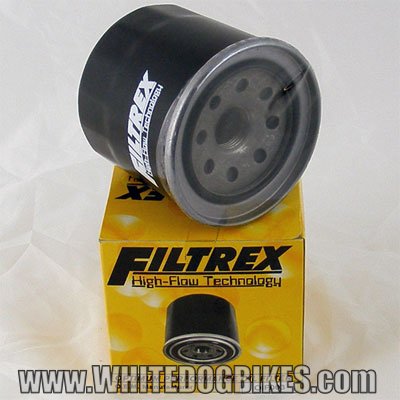
Hiflo HF202 oil filter – GPZ500S A1 to A4
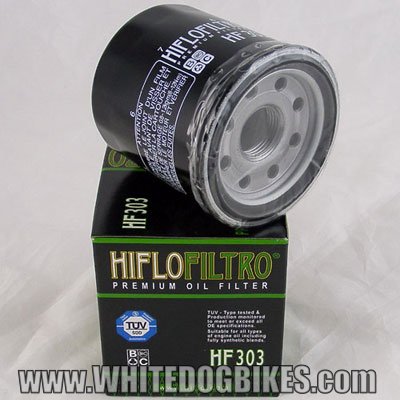
Hiflo HF303 oil filter – GPZ500S A5 model onwards…
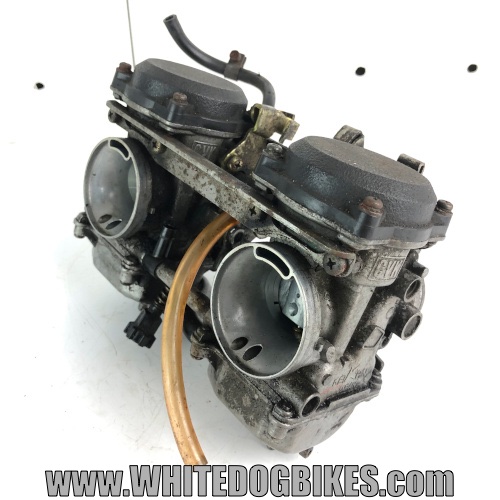
GPZ500S inline twin carbs
Carb, fuel and oil stuff….. |
|
|---|---|
| Fuel system: | Carburetor |
| MPG (average): | 45 miles per gallon (very approx) |
| Fuel tank range (approx): | 175 – 200 miles
|
| Fuel tank capacity: | 18 litres |
| Fuel type: | Unleaded petrol (95 octane grade – aka standard petrol from your local garage) |
| Carb make: | Keihin (2x) |
| Carb type: | CVK 34 (34mm flat-slide carbs) |
| Pilot screw opening (GPZ500 A – Up to 1993): | 2 turns |
| Pilot screw opening (GPZ500 A – 1993 to Jan 1994): | 1.75 turns |
| Pilot screw opening (GPZ500 D/E – Feb 1994 onwards): | 2.25 turns |
| Engine oil (GPZ500 A – Up to Jan 1994): | 10w40 API SE/SF or higher |
| Engine oil (GPZ500 D/E – Feb 1994 onwards): | 10w40 API SG or higher
|
| Engine oil capacity (GPZ500 A – Up to Jan 1994): | 3.0 litres |
| Engine oil capacity (GPZ500 D/E – Feb 1994 onwards): | 3.4 litres |
| Engine oil drain bolt location: | Bottom/underneath of the engine |
| Oil filter type: | Canister type |
| Oil filter (GPZ500 A1 to A4 – Up to Dec 1990): | Hiflo HF202 / Filtrex OIF003 |
| Oil filter (GPZ500 A5, Jan 1991 onwards): | Hiflo HF303 / Filtrex OIF006 |
| Oil filter torque: | 10nm |
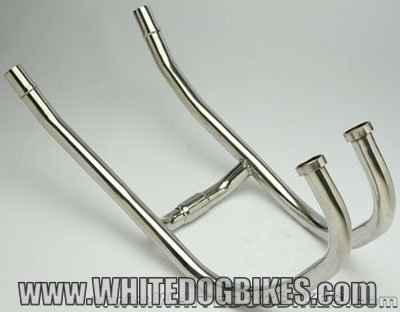
GPZ500S Aftermarket exhaust downpipes
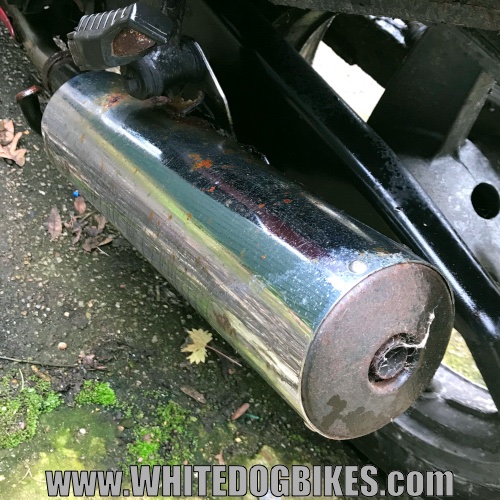
GPZ500S exhaust end can (there are 2, 1 each side, on the GPZ500)
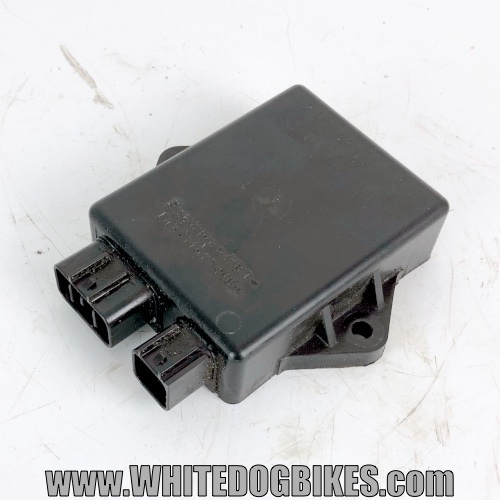
GPZ500S CDI/ignitor unit
Electric stuff….. |
|
|---|---|
| Ignition type: | Electronic CDI |
| Starter: | Electric start |
| Electrical system voltage: | 12 volts |
| Battery voltage (fully charged): | 13 to 13.2 volts |
| Battery will need charging if below: | 12.4 volts |
| Regulated voltage (GPZ500 A – Up to Jan 1994): | 14.5 volts (@ 4000 rpm) |
| Regulated voltage (GPZ500 D/E – Feb 1994 onwards): | 15 volts (@ 4000 rpm) |
| Spark plug (GPZ500 A – Up to Jan 1994): | NGK DR8ES (x2) |
| Spark plug (GPZ500 D/E – Feb 1994 onwards): | NGK DR9EA (x2) |
| Spark plug gap: | 0.6 to 0.7mm |
| Spark plug torque: | 14nm |
| Spark plug ignition: | 2 x coil |
| Battery: | CB14L-A2 / YB14L-A2 / GB14L-A2
|
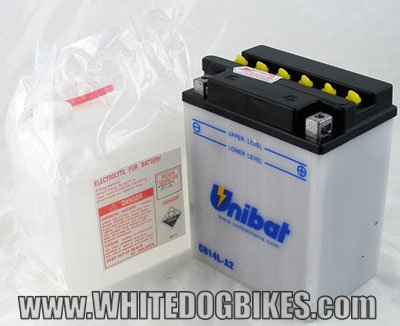
1987 to 2004 Kawasaki GPZ500S battery (YB14L-A2).
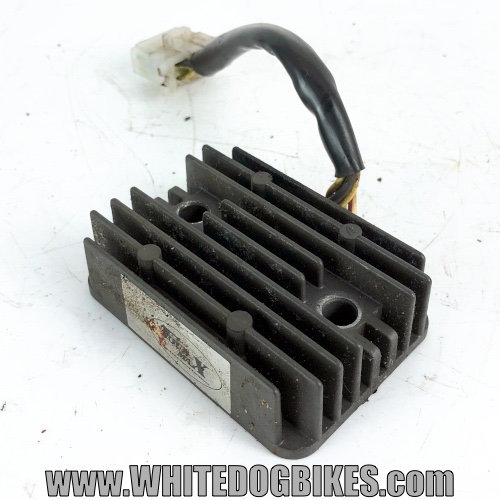
GPZ500S regulator/rectifier (also known as a reg/rec).
The reg/rec regulates the power the bike generates (and stops the voltage going too high) as well as the direction the electricity travels in.
They can generate alot of heat hence the cooling fins on this one.
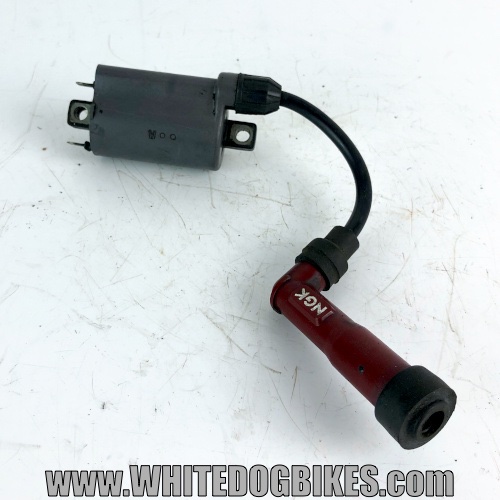
GPZ500S (EX500) spark plug coil, HT lead and plug cap
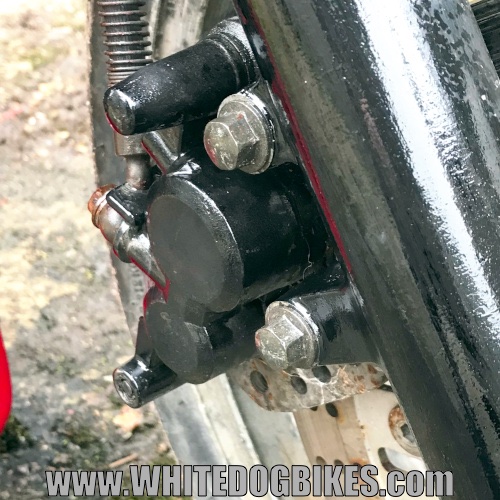
GPZ500S front brake caliper (note one larger and one smaller brake piston)
Shocks, brakes and wheel specs….. |
|
|---|---|
| Front wheel type: | 3 spoke cast wheel |
| Front tyre size (GPZ500 A – Up to Jan 1994): | 100/90-16 |
| Front tyre pressure (GPZ500 A – Up to Jan 1994): | Solo: 28psi (2 bar) / With pillon: 32psi (2.2 bar) |
| Front tyre size (GPZ500 D/E – Feb 1994 onwards): | 110/70-17 |
| Front tyre pressure (GPZ500 D/E – Feb 1994 onwards): | 32psi (2.2 bar) |
| Front wheel spindle torque: | 88nm |
| Front wheel spindle clamp bolt torque: | 20nm |
| Rear wheel type: | 3 spoke cast wheel |
| Rear tyre size (GPZ500 A – Up to Jan 1994): | 120/90-16 |
| Rear tyre pressure (GPZ500 A – Up to Jan 1994): | Solo: 32psi (2.2 bar) / With pillion: 36psi (2.5 bar) |
| Rear tyre size (GPZ500 D/E – Feb 1994 onwards): | 130/70-17 |
| Rear tyre pressure (GPZ500 D/E – Feb 1994 onwards): | 36psi (2.5 bar) |
| Rear wheel spindle torque: | 110nm |
|
|
| Front brake: | Single hydraulic disc brake with 2 piston caliper |
| Front brake disc: | 280mm single disc. Part no: EBC MD4016 (1x) |
| Front brake pad: | EBC FA129 (1x) |
| Rear brake (1987 to Jan 1994 – GPZ500S A1 to A6, drum rear brake models): | Drum brake |
| Rear drum brake pad: | EBC K706 |
| Rear brake (Feb 1994, GPZ500S D1 onwards – disc rear brake models): | Single hydraulic disc brake with single piston caliper |
| Rear brake disc: | Single 230mm disc. Part no: EBC MD4051 (1x) |
| Rear brake pad: | EBC FA067/3 (1x) |
| Brake fluid (front and rear): | DOT 4 brake fluid |
| Front suspension: | Telescopic forks |
| Front fork stanchion diameter (GPZ500 A – Up to Jan 1994): | 36mm |
| Front fork stanchion diameter (GPZ500 D/E – Feb 1994 onwards): | 37mm |
| Recommended fork oil (GPZ500 A – Up to Jan 1994): | 15w fork oil |
| Fork oil volume (GPZ500 A – Up to Jan 1994): | 287 cm3 (per fork) |
| Recommended fork oil (GPZ500 D/E – Feb 1994 onwards): | 10w fork oil |
| Fork oil volume (GPZ500 D/E – Feb 1994 onwards): | 300 cm3 (per fork) |
| Rear Suspension: | Monoshock rear suspension |
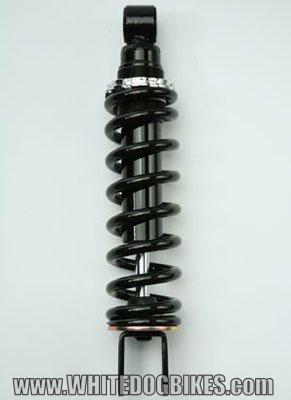
GPZ500S aftermarket rear shock absorber
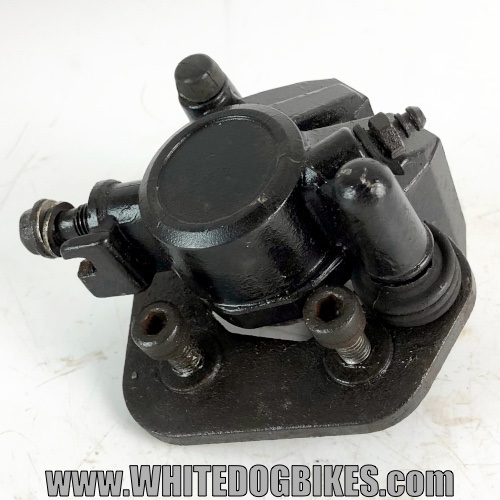
GPZ500S rear brake caliper
Weights, measures ‘n stuff….. |
|
|---|---|
| Overall length (GPZ500S A1): | 2050mm |
| Overall length (GPZ500S A2 to A6): | 2110mm |
| Overall length (GPZ500S D/E): | 2095mm |
| Overall width (GPZ500S A1 to A6): | 675mm |
| Overall width (GPZ500S D/E): | 700mm |
| Overall height (GPZ500S A1 to A6): | 1165mm |
| Overall height (GPZ500S D/E): | 1160mm |
| Wheelbase (GPZ500S A1 to A6): | 1,440mm |
| Wheelbase (GPZ500S D/E): | 1,435mm |
| Seat height (GPZ500S A1 to A6): | 770mm |
| Seat height (GPZ500S D/E): | 775mm |
| Ground clearance: | 120mm |
| Dry weight (GPZ500S A – no oils, fluids etc): | 169kg |
| Kerb weight (GPZ500S A – with oils, fluids etc): | 171kg |
| Dry weight (GPZ500S D/E – with oils, fluids etc): | 176.5kg |
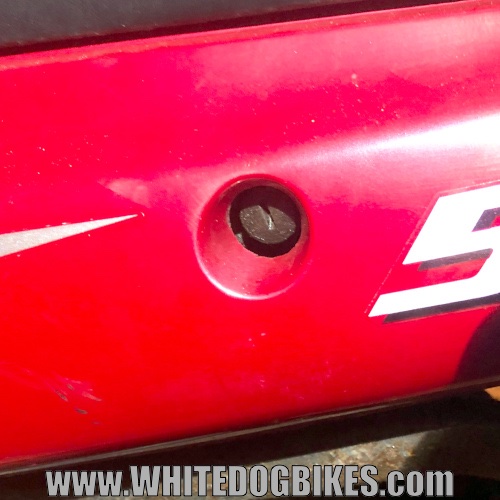
GPZ500S seat lock location (left side, just below the seat)
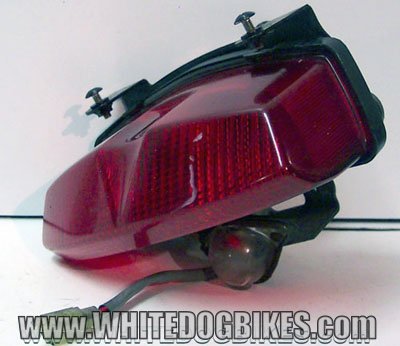
GPZ500S rear light
Useful torque settings….. |
|
|---|---|
| Cam cover: | 10nm |
| Cylinder head (stage 1): | 51nm |
| Cylinder head (stage 2 – GPZ500S D/E models): | 10nm |
| Spark plugs: | 14nm |
| Front wheel spindle (GPZ500S D/E models): | 88nm |
| Front wheel spindle clamp (GPZ500S D/E models): | 20nm |
| Rear wheel spindle (GPZ500S D/E models): | 110nm |
| Magneto / flywheel (GPZ500S A1 to A6): | 69nm |
| Magneto / flywheel (GPZ500S D/E): | 11nm |
| Cam cover: | 10nm |
| Camshaft sprocket: | 15nm |
| Clutch hub: | 130nm |
| Oil filter: | 10nm |
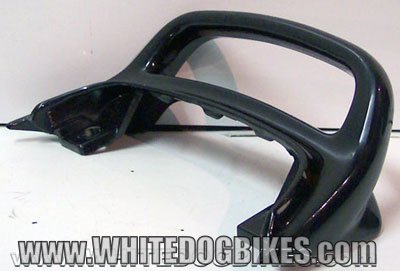
GPZ500S Pillion grab rail
<
Service stuff….. |
|
|---|---|
| Servicing your bike? You’ll need a GPZ500S workshop manual… | |
| Engine oil | |
| Engine oil check: | 3,000km (1,864 miles) |
| Engine oil change frequency: | Every 10,000km (approx 6,214 miles) or 12 months |
| Engine oil (GPZ500 A – Up to Jan 1994): | 10w40 API SE/SF or higher |
| Engine oil (GPZ500 D/E – Feb 1994 onwards): | 10w40 API SG or higher
|
| Engine oil capacity (GPZ500 A – Up to Jan 1994): | 3.0 litres |
| Engine oil capacity (GPZ500 D/E – Feb 1994 onwards): | 3.4 litres |
| Engine oil drain bolt location: | Bottom/underneath of the engine |
| Oil filter (GPZ500 A1 to A4 – Up to Dec 1990): | Hiflo HF202 / Filtrex OIF003 |
| Oil filter (GPZ500 A5, Jan 1991 onwards): | Hiflo HF303 / Filtrex OIF006 |
| Oil filter torque: | 10nm |
| Chain drive | |
| Final drive chain frequency: | Now repeat after me… ‘I MUST LUBE MY CHAIN LITTLE AND OFTEN!!’ |
| Chain and sprocket size: | 104 link / 520 Pitch chain 16 Tooth front sprocket 42 Tooth rear sprocket |
| Hydraulic brake system (front and rear) | |
| Brake fluid change frequency: | Change every 24 months or 20,000km (approx 12,427 miles) |
| Brake fluid: | DOT 4 brake fluid |
| Fork oil | |
| Front fork oil change: | 30,000km (approx 18,641 miles) or 36 months |
| Recommended fork oil (GPZ500 A – Up to Jan 1994): | 15w fork oil |
| Fork oil volume (GPZ500 A – Up to Jan 1994): | 287 cm3 (per fork) |
| Recommended fork oil (GPZ500 D/E – Feb 1994 onwards): | 10w fork oil |
| Fork oil volume (GPZ500 D/E – Feb 1994 onwards): | 300 cm3 (per fork) |
| Cooling system | |
| Change every: | 30,000km (approx 18,641 miles) or 24 months |
| Cooling system: | Liquid cooled |
| Cooling system capacity: | 1.8 litres |
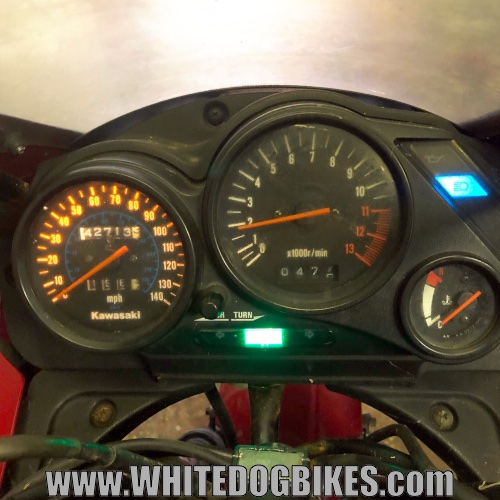
GPZ500S clocks showing main light beam light, neutral gear light, speedo, rev counter and temp gauge
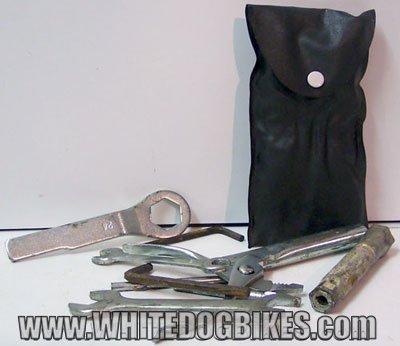
Genuine tool kit from a 1998 GPZ500S D5
Frame number location…..
The frame number is usually stamped onto the right side of the headstock (the front part of the frame just below the handle bars).
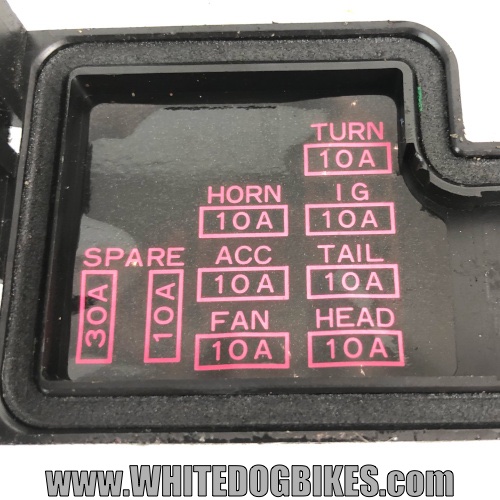
GPZ500S fuse box diagram showing the positions of different fuses in the fuse box
Useless stuff…..
Surprisingly sporty middle weight bike which has withstood the test of time. Although the bike was called the ‘GPZ500S’ in Europe, it was originally called the ‘EX500’ in other areas (like the US). The bike name was changed in 1994 from EX500 to Ninja 500 and then to the Ninja 500R in 1998.
The bikes high revving and sporty nature meant it was used in the ‘production twins’ racing class in the US as well as several racing series.
Because the bike was quite forgiving if you made a mistake whilst riding, it proved popular with new racers getting into bike racing and new ‘big bike’ road going owners.
Kawasaki designed the bike to be reasonably cheap and easy to maintain which meant it was a popular bike with commuters and experienced riders looking to bike on a budget.
The GPZ500S was discontinued in the UK in 2004, probably partly due to the engine not meeting the new Euro 2 emissions regulations.
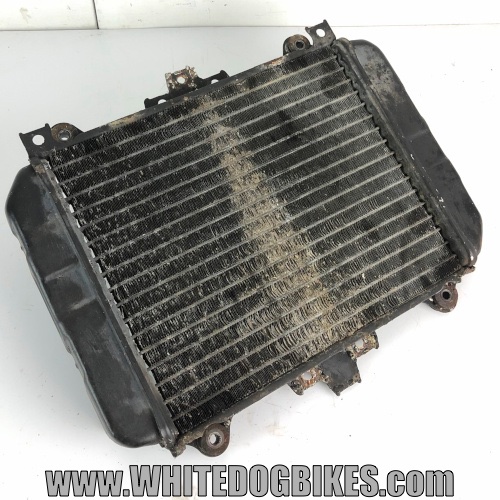
GPZ500S radiator
Buying advice…..
Firstly, if your thinking of buying one always HPI check it (there’s still loads about so no point risking getting stuck with a lemon!).
These are good, reliable and are ideal for both experienced riders on a budget and riders looking for their 1st ‘big bike’.
Although servicing and running costs are fairly cheap and the bike is fairly bullet proof you do tend to get what you pay for, obviously a bike that’s had frequent oil changes and has a good service history is likely to be better.
As the bike had a fairing, it wasn’t very popular with rider training schools (unlike other twins like the CB500), but it was a reasonably popular courier bike and was used in a few racing series which means there are likely to be a few dog’s out there.
Exhaust downpipes and headers do rot though (mild steel!), so in the unlikely event of the bike having the original headers, best to budget for replacing them. (however due to them being a twin with a simple exhaust design, end can’s and downpipes are readily available and not stupidly overpriced.
The only other thing to consider when buying one is the age. The youngest of these beasties will be over 14 years old now, so if your buying one give it a good check over, especially rear shocks, fork stanchion condition (helps if the forks have had fork gaitors fitted), radiator (damage, leaks look for white water trails from the rad of pipework), handle bar switches, ignition, battery etc.
Obviously, it’s worth paying a bit more for a lower mileage bike with a small rainforest of service paperwork then one of the ‘barn find’ type bikes that seem to be cropping up regularly.
Happy biking 🙂
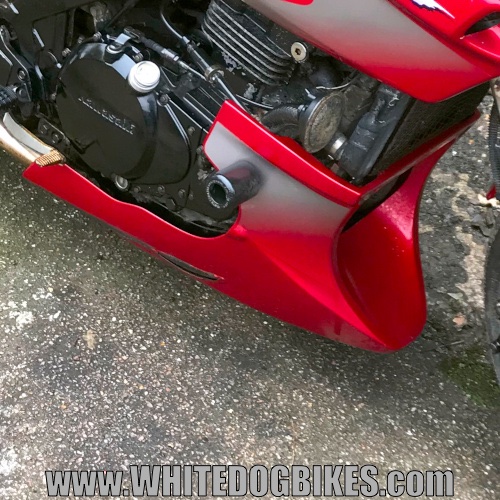
GPZ500S belly pan in candy red
Sources / Thanks to / Useful GPZ500 / EX500 sites:
GPZ500S article on MCN
Article written by an EX500 owner
www.ex-500.com/ Loads of helpful owners and info
If you’ve got any questions, comments or suggestions please feel free to leave them below 🙂
Disclaimer: The information on this page is correct to the best of our knowledge. But the info should NOT be taken as 100% accurate as we can, occasionally make mistakes!

Leave a Reply